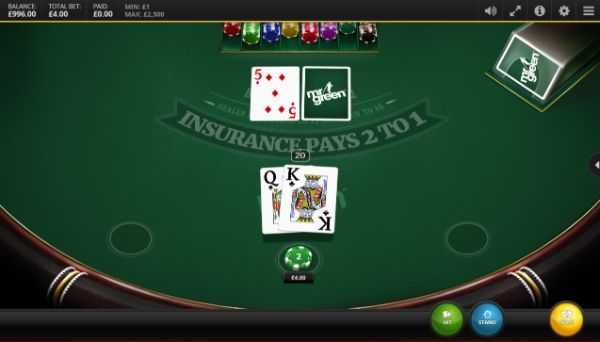You’ve heard it many times - Blackjack is one of the Casino games with the best odds.
But what does it really mean?
In a nutshell, when played correctly, Blackjack hasone of the lowest house edges of all Casino games.
Emphasis on played correctly.
The players are in charge of the decisions that reduce the House edge. But for that, you need to understand Blackjack odds and probabilities.
Don’t worry, though. You don’t need to be a mathematics genius for that.
All the Blackjack odds are explained in a simple manner in this article.
Blackjack Odds: The House Edge
Let’s start with the simple terms - well-known and used - the house edge.
When You Don’t Follow Any Strategy
Remember the first time you’ve played Blackjack.
You’ve just read the rules or someone quickly explained them to you. You didn’t take a look at any strategies or tips on how to play. And you’ve got dealt your first hand.
This is the time where Blackjack is the most confusing. When the rules are still fresh and no Blackjack strategy is put into place.

That’s when some players rush to hit on hard 18 or stand on 11 without giving it any thought. Such moves give you a greater house edge than many Casino games, including Video Slots, combined.
Of course, those are the obviously wrong decisions that you can learn not to make pretty quickly on your own. And once you do, the house edge drops to 2 to 3 percent.
But every decision affects the house edge, so each time they play, it can be different.
When you Follow Basic Strategy
You get the best house edge when you play perfectly according to the basic strategy.
How does it affect the House edge?
Blackjack with basic strategy has a House edge of only 0.5 percent or lower.
And that’s as good as it can get in a Casino.
What Else Affects The House Edge
The main thing that affects the house edge is the decisions that you make during the game.
Hit or stand, double down or split, take insurance or surrender.
It all affects the odds.
While you can make the most of your decisions by following the basic strategy, it won’t remove the house edge completely.
That’s just how the game was designed.
You cannot have even odds with the house because the rules insist you play out your cards first.
If the dealer played their cards first, you could stand on 16 with a clean conscience, knowing that the dealer went bust.

But since you play first, you don’t know if the dealer goes bust. If they don’t, 16 is not a good enough hand to stand on.
And then, of course, there are things like the player or House-favorable rules that can make the house edge higher or lower.
For example, the decks of cards used.
When it’s a single-deck game, House has an edge of 0.04 percent. But apart from single-deck Blackjack games online, it’s a pretty rare case.
Usually, Casinos use up to eight decks at a time. Especially to confuse the card-counters. With each deck, the house gets a bigger advantage.
| Decks Used | House Advantage |
|---|---|
| One | 0.04% |
| Two | 0.42% |
| Four | 0.61% |
| Six | 0.67% |
| Eight | 0.7% |
[promo=89][/promo]
Probability of Dealer’s Hands
If you take a look at the basic strategy charts, you see that knowing the dealer’s face-up card is as essential as knowing your own.
Why?
It gives you a glimpse on whether the dealer will have a strong or a weak hand.
For example, when the dealer shows a 2, their final hand most likely would end up in a bust (35 percent chance) or they would stand on 17 (14 percent chance). 13 percent of the time, they may get have an 18, 19, or 20, and 12 percent of the time - a 21.
For remaining probabilities of the dealer’s final hand, check the table below.
Important: probabilities of the dealer landing a natural Blackjack are excluded from the table.
In most of the variations, the dealer checks their hole card and if they have a Blackjack, you’d lose before making any moves.
If they don’t look at their hole card, 31 percent of the time, they’ll have a 10-value card to make up a natural Blackjack anyway.
| Dealer’s Face-Up Card | Dealer’s Final Hand | |||||
| Bust | 17 | 18 | 19 | 20 | 21 | |
| A | 17% | 19% | 19% | 19% | 18% | 8% |
| 2 | 35% | 14% | 13% | 13% | 13% | 12% |
| 3 | 38% | 13% | 13% | 12% | 12% | 12% |
| 4 | 40% | 13% | 12% | 12% | 12% | 11% |
| 5 | 43% | 12% | 12% | 12% | 10% | 11% |
| 6 | 42% | 17% | 10% | 11% | 10% | 10% |
| 7 | 26% | 37% | 14% | 8% | 8% | 7% |
| 8 | 24% | 13% | 36% | 13% | 7% | 7% |
| 9 | 23% | 13% | 10% | 36% | 12% | 6% |
| 10 | 24% | 12% | 12% | 12% | 36% | 4% |
What does the table tell you?
You can take advantage of situations when the dealer has a ‘weak hand’.
For example, when they have a 5 or 6, it’s most likely the dealer will bust. So, with most of your hard hands above 12, it makes sense to stand and wait until the dealer busts.
Other moves can be based accordingly.
Of course, for that, you need to take into account your cards, too.
And just like you can use Blackjack odds to predict the dealer’s final hand, you can predict your own.
[promo=89][/promo]
Probability of Player’s Hands
The biggest worry when playing Blackjack is whether one more card would make you bust.
You may not have that worry if your hand is 11 or lower, or if it’s a soft hand. But all the other times, it will make you doubt your hand and/or even doubt the correct basic strategy.
Imagine this.
You have a 12 and the dealer shows a 4.
The basic strategy cheat sheet tells you to stand.
But you don’t have the mathematical calculations running in the back of your head, so you don’t want to agree with this move.
Been there, done that.
The card seems to have a low value, it feels like there is no harm in getting an extra card.
But it can make you bust. And if the dealer goes bust, you can be sure you’ll regret you went down with them.
Knowing your Blackjack odds, though, helps to understand similar suggestions in the basic strategy charts.
So, what are your chances of going bust with 12-value when you hit exactly?
That would be 31 percent, my friend.
The rest of your hand probabilities of going over 21 with an extra card are listed in the table.
| Your Hand Value | Probablity of Going Over 21 When You Hit |
|---|---|
| 11 or lower | 0% |
| 12 | 31% |
| 13 | 39% |
| 14 | 56% |
| 15 | 58% |
| 16 | 62% |
| 17 | 69% |
| 18 | 77% |
| 19 | 85% |
| 20 | 92% |
| 21 | 100% |
Take that in, understand your odds, and… forget it.
You don’t need to think about it yourself every time you play Blackjack.
That’s what the basic strategy is for.
It already took all the odds into account and shows you the best moves you can make.
The only thing you need to do is to follow the basic strategy.
And don’t question it.
If you have trust issues, then go ahead and calculate the odds yourself. It will take a while but you’ll end up seeing basic strategy is the way to go anyway.
House vs Player-Favorable Blackjack Rules
Now let’s dive into the player-favorable rules that you can improve your odds in Blackjack games.
Blackjack is the most popular Casino table game, so no wonder there are plenty of Blackjack variants and games with modifications to the rules.
Some are improving your Blackjack odds, some are making them worse.
Taking Insurance

I won’t explain the Blackjack odds behind the insurance because you can read all about it here.
But let’s get one thing straight - insurance is almost NEVER a good move to make.
Every single one of the Blackjack strategies will tell you that much.
Insurance can only give you an advantage in the long run if you know the art of card counting.
Otherwise, ignore it or choose a game where insurance option is not even available.
[promo=89][/promo]
Natural Blackjack Payouts
At most Casinos, both brick-and-mortar and online, a natural pays 3 to 2.
Since it’s the most common payout, you may get used to it. But if you find a Casino that pays 2 to 1 for a natural blackjack, you hit the jackpot.
Not literally, but you get the idea.
You’ll get a better payout for the natural blackjack, hence, also better odds in the long run.
Double Down Availability
Another player-favorable rule goes down to the double down option.
First, don’t ignore this move. I’ve already explained when to double down here. This move can really help to improve your odds.

When it comes to its availability, some Casinos strict the move to certain value hands only.
For example, you can only double down on 9, 10, or 11-value hands or one of those.
If you have an option, choose a Casino game that allows you to double down on any kind of hand-value.
It’s also better if you can still double down after splitting pairs.
Some Blackjack tables restrict it. Some may allow to double down after a split and some may allow to double down after most splits, except for Aces.
Early and Late Surrender Option
Unlike double down, surrender is a lot less common move you can make in Blackjack.
When you play online, sometimes it comes down to finding games that have Surrender in their title.
Early Surrender gives you a chance to, well, surrender. You can use it when the dealer shows a 10 or an Ace and BEFORE they check their hole card.
Late Surrender gives you the same chance but only AFTER the dealer checks their hole card. Thus, if they have a natural, you would lose before you could surrender.
When you surrender, you get half of your bet back. So, when you see that you have less than 50 percent chance to win, it may be a good way to go.
Six-Card Winner (Charlie)
In some Blackjack games, you can win not only if you successfully get more cards than the dealer but also if you have a six-card hand (sometimes five or seven-card instead) without going bust.
That’s often called a Charlie and it’s another player-favorable rule of Blackjack.
Of course, it’s rare to find it in place at Casinos and even when it’s there, you won’t have six-card hands too often.
But in the long haul, it does add up to your winning odds.
And it's a fun twist in the game, partly the reason players love Blackjack variants such as Pontoon card game.







